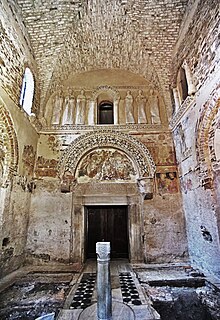This article needs additional citations for verification. (July 2016) |
Duchy of Friuli Ducatus Foroiuliensis (Latin) | |||||||||
|---|---|---|---|---|---|---|---|---|---|
| 568–828 | |||||||||
 The Duchy of Friuli in the northeast within Lombard Italy | |||||||||
| Status | |||||||||
| Capital | Cividale | ||||||||
| Common languages | |||||||||
| Government | Duchy | ||||||||
| Duke of Friuli | |||||||||
• 568-~584 or 568/c.584–590 | Grasulf I or Gisulf I (first) | ||||||||
• 774-776 | Hrodgaud | ||||||||
• 819-828 | Baldric (last) | ||||||||
| Historical era | Early Middle Ages | ||||||||
• Established | 568 | ||||||||
• Avar invasion | 610 | ||||||||
• Lombard Kingdom conquered | 773-774 | ||||||||
• Divided into smaller counties | 828 | ||||||||
• Reestablished as the March of Friuli | 846 | ||||||||
| |||||||||
| Today part of | Friuli-Venezia Giulia | ||||||||
The Duchy of Friuli (Latin: Ducatus Foroiuliensis) was a Lombard duchy in present-day Friuli, the first to be established after the conquest of the Italian peninsula in 568. It was one of the largest domains in Langobardia Major and an important buffer between the Lombard kingdom and the Slavs,[1] Avars, and the Byzantine Empire. The original chief city in the province was Roman Aquileia, but the Lombard capital of Friuli was Forum Julii, modern Cividale.

Along with the dukes of Spoleto, Benevento and Trent, the lords of Friuli often attempted to establish their independence from the royal authority seated at Pavia, though to no avail. After the Lombard campaign of Charlemagne and the defeat of King Desiderius in 774, the last Friulian duke Hrodgaud ruled until 776. Upon his death, Friuli was incorporated as a march of the Carolingian Empire.
- ^ Thomas Hodgkin, Italy and Her Invaders, vol. 5:160.